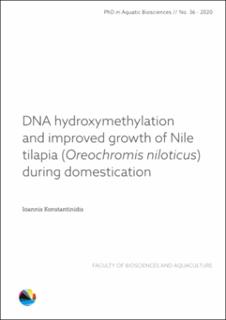| dc.contributor.advisor | Fernandes, Jorge Manuel de Oliveira | |
| dc.contributor.advisor | Sætrom, Pål | |
| dc.contributor.author | Konstantinidis, Ioannis | |
| dc.date.accessioned | 2021-07-29T11:34:41Z | |
| dc.date.available | 2021-07-29T11:34:41Z | |
| dc.date.created | 2020-12-11T04:59:46Z | |
| dc.date.issued | 2020 | |
| dc.identifier.citation | Konstantinidis, I. (2020). DNA hydroxymethylation and improved growth of Nile tilapia (Oreochromis niloticus) during domestication (Doctoral thesis). Nord University. | en_US |
| dc.identifier.isbn | 978-82-93165-36-1 | |
| dc.identifier.uri | https://hdl.handle.net/11250/2765617 | |
| dc.description | Doctoral thesis (PhD) - Nord University, 2020 | en_US |
| dc.description.abstract | The worldwide demand for fish consumption is highly dependent on aquaculture production because commercial fishing reached its maximum exploitation since the 90’s. However, continued expansion of the aquaculture industry in a sustainable manner is dependent on several factors, including domestication of new species and establishment of selective breeding programmes. Domestication of new fish species is a rather complex and long process but the deployment of new molecular tools could improve and accelerate it through the holistic characterization of fish genomes. This thesis is based on the hypothesis that epigenetic mechanisms underlie genome-wide adaptation under captivity, since genetic mutations and allele shifts alone cannot explain the rapid transcriptomic changes of fish undergoing domestication. In a series of experiments, we investigated the role of DNA hydroxymethylation during the early stages of fish domestication, and its potential involvement in regulating somatic growth. At first, we discovered that the DNA hydroxymethylome in fast muscle changes rapidly within a single generation of domestication. As a result of our 5-hydroxymethylcytosine (5hmC) profiling at single nucleotide resolution, we were able to identify that 5hmCs are largely enriched within gene bodies, which supports the notion that they are functionally relevant epigenetic modifications. The annotation of differentially hydroxymethylated genes between wild and first-generation of fish under captivity revealed that the changes occurred primarily within genes involved in immunity, growth and neuronal activity. By comparing gene expression profiles in muscle between wild and first generation of Nile tilapia in captivity, we showed that immune-related genes were upregulated in the wild fish, while genes involved in metabolism and muscle-specific functions were downregulated. These findings revealed that the first generation of fish undergoing domestication is strongly influenced by the environmental conditions under captivity, namely the lack of pathogens and the optimal conditions of water temperature, oxygen, pH and diet. Thus, we provided for the first time a link between environmentally-mediated DNA hydroxymethylation and gene regulation in fish undergoing domestication. To further explore the connection between DNA hydroxymethylation and somatic growth, we compared the liver hydroxymethylomes of slow- and fast-growing full siblings and examined the 5hmC abundance in three major tissues that compose the somatotropic axis. Interestingly, we identified several differentially hydroxymethylated genes between slowand fast-growers. These genes were involved in signaling pathways related to cell growth, survival and proliferation such as the PI3K-Akt, the Ras- and Rho- protein signal transduction pathways. By comparing the DNA hydroxymethylomes among the muscle, liver and pituitary, we identified several differentially hydroxymethylated growth factors, receptors and enhancers with major implications in growth, metabolism and skeletal muscle development. Taken together, this thesis provides for the first time a direct link between DNA hydroxymethylation and fish domestication and associates epigenetic marks at single nucleotide resolution to somatic growth using cutting-edge molecular tools. When validated, these epigenetic markers can potentially improve current breeding strategies in aquaculture by providing a holistic approach for broodstock selection. | en_US |
| dc.language.iso | eng | en_US |
| dc.publisher | Nord University | en_US |
| dc.relation.ispartofseries | PhD in Aquatic Biosciences;no. 36 | |
| dc.relation.haspart | Paper I: Konstantinidis, I., Sætrom, P., Mjelle, R., Nedoluzhko, A., Robledo, D. & Fernandes, J. M. de O. (2020). Major gene expression changes and epigenetic remodelling in Nile tilapia muscle after just one generation of domestication. Epigenetics. doi: 10.1080/15592294.2020.1748914. Fulltext available in Nord Open: https://hdl.handle.net/11250/2660427 | en_US |
| dc.relation.haspart | Paper II: Konstantinidis, I., Sætrom, P., Brieuc, M. S., Baaksrud, H. T., Jakobsen, K. S., Liedtke, H., Pohlmann, C., Tsoulia, T. & Fernandes, J. M. O. (forthcoming). DNA hydroxymethylation differences underlie early phenotypic divergence of somatic growth during fish domestication. Fulltext is not available in Nord Open. | en_US |
| dc.relation.haspart | Paper III: Konstantinidis, I., Anastasiadi, D., Sætrom, P., Nedoluzhko, A. V., Mjelle, R., Podgorniak, T., Piferrer, F. & Fernandes, J. M. O. (2021). Epigenetic mapping of the somatotropic axis in Nile tilapia reveals differential DNA hydroxymethylation marks associated with growth. Genomics, 113(5), 2953-2964. doi: 10.1016/j.ygeno.2021.06.037. Fulltext available in Nord Open: https://hdl.handle.net/11250/2765312 | en_US |
| dc.relation.haspart | Please note: Links to articles are only included if they are made available in the archive. | en_US |
| dc.title | DNA hydroxymethylation and improved growth of Nile tilapia (Oreochromis niloticus) during domestication | en_US |
| dc.type | Doctoral thesis | en_US |
| dc.description.version | publishedVersion | en_US |
| dc.rights.holder | © Ioannis Konstantinidis, 2020 | en_US |
| dc.subject.nsi | VDP::Landbruks- og Fiskerifag: 900::Fiskerifag: 920::Akvakultur: 922 | en_US |
| dc.subject.nsi | VDP::Matematikk og Naturvitenskap: 400::Basale biofag: 470::Genetikk og genomikk: 474 | en_US |
| dc.subject.nsi | VDP::Matematikk og Naturvitenskap: 400::Zoologiske og botaniske fag: 480::Zoofysiologi og komparativ fysiologi: 483 | en_US |
| dc.source.pagenumber | 179 | en_US |
| dc.identifier.cristin | 1858547 | |
| dc.relation.project | Research Council of Norway: 250548 | en_US |
| dc.relation.project | EC/H2020/683210 | en_US |
